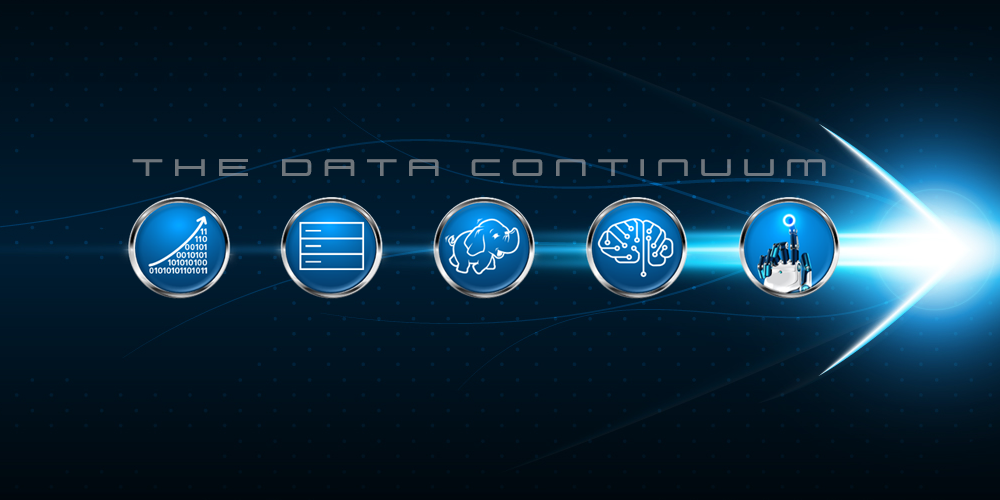Meeting frequently with customers, partners and industry analysts, I engage in some terrific conversations. We discuss what Dell EMC customers care about today. That is, what’s motivating IT professionals now compared with just a year or two ago, and what do they want Dell EMC to help them accomplish, from an infrastructure and services perspective?

This leads always to the topic of transformation—how, in 2018, people in IT are far less concerned with product features and price points than they are with using technology to deliver business outcomes, like creating new business models, expanding revenue streams and ensuring exceptional customer experience.
This shift all comes down to data—the evolving role it plays in the world and in the enterprise. We can think about the role of data as having five stages that I refer to as the data continuum. The digitally transformed organization must think through technology and infrastructure decisions across all of these stages:
- Creation of data: It used to be that traditional applications were the primary source of data. Today, with cloud-native applications, edge computing, IOT/sensor data, the volume and variety of data types are growing significantly
- Storage of data: With the massive increase in data sources and types, storage of data has had to evolve as well. Software-defined architectures, which allow for multi-dimensional scaling while supporting both traditional and modern applications, are in high demand. Data Storage is no longer focused primarily on compliance and regulation but on managing, protecting and securing data as the high-value asset that it is.
- Analysis of Data: Data analytics have always existed, even before the arrival of digital data we speak of today. With support from technologies like Hadoop and open source tools, analytics applications that once focused primarily on structured data now encompass unstructured formats as well, like text and multi-media content.
- Learning from Data: A natural extension of widespread analysis of structured and unstructured data is the ability to learn from data. This is where Machine Learning comes in, and where the right combination of infrastructure, tools and frameworks allow systems themselves to learn from the analysis data.
- Acting on Data: This is where systems can substitute for human intelligence by leveraging the patterns in analysis they have performed, extracting insights from data, making decisions and taking action on that data, with or without human intervention.

Making the continuum real
These five stages of the data continuum align closely to the ways we at Dell EMC approach IT transformation and make it real for you. At every phase in the continuum, our products and solutions are there, making the data-driven business possible for you:
Dell EMC servers and platforms for traditional and cloud-native applications, workstations and edge gateways for IoT solutions— all are sources of data creation. VxRack SDDC with VMware Cloud Foundation, Pivotal Ready Architecture, Virtustream Enterprise Cloud Platform, Dell EMC Cloud on Azure Stack and, of course, PowerEdge Servers are examples of our offerings in this space.
For storage of data, we offer the broadest portfolio of next-generation products, across entry, midrange, high-end and unstructured data storage, meeting the performance, capacity or data services requirements for pretty much every application in your data center. We also offer consumption choices, from converged and hyper-converged infrastructure to cloud services. And, since an asset as valuable as data also needs to be carefully protected, we offer industry-leading data protection solutions as well.
To support analysis of data, we offer Ready Solutions for SAP, Splunk and Hadoop. In addition, we have HDFS natively integrated into our storage platforms to help you do in-place analytics.
To help you learn from data, we offer servers and Ready Solutions for Machine Learning and Deep Learning, they include the infrastructure, frameworks, software and tools you need to train your applications and help them become more and more intelligent.
Artificial Intelligence and Machine Learning are not just something our platforms help others to achieve. We apply both within our own products, directly benefitting you with systems like the PowerMax array, that learns from and acts on your data, making up to 6 billion decisions a day, simplifying management experience and maximizing performance with no overhead. Using solutions like CloudIQ, Dell EMC solutions continuously learn from and act on your data with proactive monitoring and predictive analytics.
What’s your continuum story? Are you using data in ways that help you achieve maximum business outcomes? With a portfolio of solutions and services that make the data continuum real, Dell EMC can help you become a more strategic business influencer, using the power of data to build new revenue models and deliver outstanding customer experiences. Please contact us to start a discussion or respond to me directly in the comments section below.
For more context on this topic, view my May 2018 CUBE conversation below. You can also check out Dell EMC’s commitment to AI and ML technologies